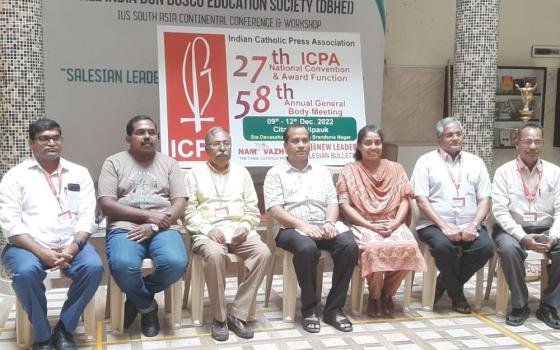
Essay
In mid-November, the New York-based Human Rights Watch weighed in on the Stupak amendment to the U.S. health care reform bill. If signed into law, the amendment would prohibit using a federal subsidy to purchase an insurance plan that includes coverage of abortion except in cases of life endangerment, rape or incest. The bill’s restriction, Human Rights Watch argued, “would effectively eliminate abortion access for millions of women and threatens women’s human rights.”
I love Human Rights Watch, the international organization that monitors the violations of human beings all around the world. I consult them whenever I can. With their careful cataloging of persecutions, their reports remind me of the ineffable truth that human beings are made in the image of God and as such don’t deserve to be bombed, raped, demeaned or disregarded. But the organization’s classification of unrestricted and subsidized access to abortion as a “human right” has left me stammering, for when considered in detail, abortion does not evoke a sense of possibility, my typical response to a right realized. Instead, I feel despair.
In “We Do Abortions Here: A Nurse’s Story” (Harper’s Magazine, October 1987), Sallie Tisdale writes with heartbreaking and brutal precision about her work at a clinic that averaged 100 abortions a week. A believer in the telescopic view, she is unflinching in her description of the “disarmingly simple” abortion procedure, describing how her patient lies bare, feet in stirrups, while a doctor inserts a tube and sunctions the uterus. The machine thumps softly, and then in the basin Tisdale holds, curd-like clots of blood reveal “an elfin thorax,” beside which swim a translucent arm and hand. She also tells of the doctor who reached into the uterus of a five-month pregnant woman to manually crush her child and of the induced delivery that yielded a 20-week-old fetus, whole and intact. “It was just like a kitten,” said the nurse who caught the child. “Everything was still attached.”
Tisdale admits to having “fetus dreams.” She dreams of “buckets of blood splashed on walls” and “fetuses crawling in the trees,” and then wakes and thinks of kitchen tables, coat hangers, and women “clutching a pillow in their teeth to keep the scream from piercing apartment walls.”
Here are the worrisome details for those of us opposed to abortion. Maternal mortality rates tend to be higher in countries where abortion is illegal. According to “My Rights, My Rights to Know,” a 2008 Human Rights Watch report on abortion access in Peru, the country prohibits abortion except when the mother’s life is at risk or she faces serious and permanent damage to her health. The report notes that even in those instances where abortion is permitted, women are rarely informed. Despite the restrictions, the practice is widespread. One study estimates the number of abortions performed annually to be at 325,000, or one per live birth. Peru also has the second highest maternal mortality in Latin America. “Women have a right to life,” says the report. And they do. As do the preborn.
Established in 1972, Feminists for Life opposes abortion and its criminalization. “We can do better” is their motto. The organization rightly recognizes that in making abortion access the defining right for women (the National Organization for Women calls it the “most fundamental right for women, without which all rights are meaningless”), we spare ourselves from asking the crucial questions: Why do so many abortions occur and what are the alternatives? I recently read a biography of an illiterate Lebanese woman who fled an arranged marriage to marry the man she desired. Their union was passionate and the woman found herself carrying more children than she wanted. Scattered between her seven live births were self-induced miscarriages brought on by throwing herself out of bed and drinking potent teas. Access to abortion might have facilitated the termination of her pregnancies, made the process safer, but would it have rectified her fundamental problem -- a disconnect from her body? Would it have empowered her to make a choice in the bedroom?
“Women have abortions,” writes Tisdale, “because they are too old and too young, too poor and too rich, too stupid and too smart. I see women who berate themselves with violent emotions for their first and only abortion and others who return three, five times, hauling two or three children, who cannot remember to take a pill or where they put the diaphragm. We talk of choice. But the choice for what? ... And there is freedom. Freedom from failure, faithlessness. Freedom from biology.”
Maybe autonomy is a delusion. The “our bodies, ourselves” movement rightfully fought to elevate women above the classification of breeder or sexual commodity, but, perhaps in the process, bought into a stunted understanding of what it means to be a human being. In their defense of abortion, the early feminists often asked, “Is biology destiny?” Yes, it ultimately is. For women. And for men. Creatures of the natural world, we harbor wombs and eggs, and fertile sperms that enable us to procreate. We age and degenerate. We die and decompose.
The founding mothers of the women’s movement did not regard their bodies so hostilely. They unanimously opposed abortion, referring to it as “infanticide.” Far from regarding abortion as a woman’s “human right,” Elizabeth Cady Stanton, organizer of the first women’s rights convention in Seneca Falls, N.Y., thought it regressive. “When you consider that women have been treated as property, it is degrading to women that we should treat our children as property to be disposed of as we see fit.” Years ago, I heard ecofeminists critique abortion as yet another example of the male notion of employing technology to rearrange and control the natural order.
The Human Rights Watch report urging better abortion access in Peru recounts two stories of women who conceived children that were discovered to be malformed while still in uteri. The children were not expected to live and the mothers wanted to avoid laboring into a loss. Reading these, I thought of Frida, the firstborn of my friend, a young mother in New York. Frida was born with fatal deformities revealed only after an arduous, unproductive labor and C-section. This had been a midwife-monitored pregnancy with few ultrasounds. The infant lived nine hard days before dying peacefully in her mother’s arms. My friend admits the meaning of her daughter’s brief life remains a mystery to her. Asked if she would have aborted had she known what lay ahead, she thought a moment and then said, “No. Probably not.”
Abortion advocates and opponents speak fervently, as they should, about the right to life. But life, when fully lived, is capricious and far larger than we imagine. Albert Einstein once described human beings as “part of the whole, called by us a universe. Although we regard ourselves as “something separate from the rest,” this is “an optical delusion of consciousness,” a “prison” restricting affection and desire. Our task, he believed “was to widen the circle of compassion to embrace all living creatures and the whole of nature in its beauty.” St. Paul advised similarly when he said to see Christ in all. It is this larger life each of us has a right to and this right will never fully be realized through law, only through love.
[Claire Schaeffer-Duffy lives in Worcester, Mass. and writes frequently for NCR.]
| Special Coverage for the National March for Life
To mark the 37th annual March for Life in Washington, NCR has prepared a series of articles that will appear on our Web site Jan. 21 and Jan. 22.
|




